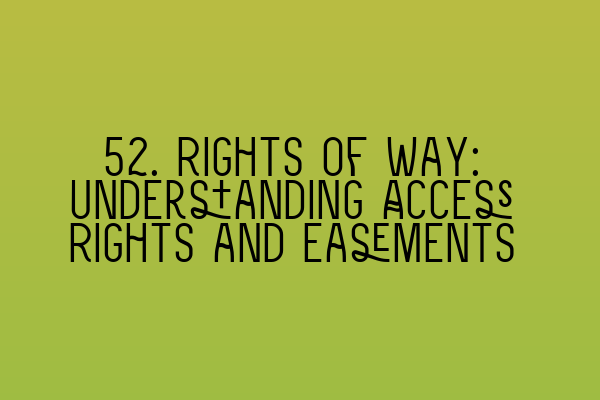52. Rights of Way: Understanding Access Rights and Easements
When it comes to property law, it is essential to have a clear understanding of the rights and responsibilities that come with owning or using a piece of land. One important aspect of property law is the concept of rights of way and easements. In this article, we will delve into the intricacies of access rights and easements, providing you with a comprehensive guide to understanding these legal terms.
1. What is a Right of Way?
A right of way refers to the legal right of a person to pass over someone else’s land. This right allows an individual, or sometimes a group of individuals, to access a specific location or use a particular pathway that runs through someone else’s property.
It is important to note that a right of way does not confer ownership of the land itself, but merely the right to use it for a specific purpose. This right can be temporary or permanent, and it can be granted to individuals, businesses, or even the general public.
2. Types of Rights of Way
There are several different types of rights of way, each with its own legal implications. Some common types include:
- Public Rights of Way: These are rights of way that are open to the general public, allowing them to access certain areas such as footpaths, bridleways, or byways. Public rights of way are usually established by historical use or specific legal designation.
- Private Rights of Way: These are rights of way that are granted to specific individuals or groups of individuals. Private rights of way are usually created through legal agreements or property deeds.
- Easements: An easement is a right that one party has over another party’s land. It can include a right of way, but it can also encompass other rights such as the right to access utilities (e.g. water, gas, or electricity) that are located across someone else’s property.
2.1 Creating a Right of Way
A right of way can be created in several ways, including:
- Express Grant: This is when the owner of the land grants a right of way to another party through a specific legal document, such as a deed.
- Prescription: This is when a right of way is acquired through continued use of a pathway or routeway over a long period of time, usually 20 years or more.
- Necessity: This is when a right of way is deemed necessary for the reasonable enjoyment of a property, such as when a property is landlocked and requires access through another property.
3. Rights of Way Disputes
While rights of way are meant to provide clarity and ensure fair access to land, disputes can sometimes arise. These disputes often revolve around issues such as the extent of the right of way, the maintenance responsibilities, and any limitations or restrictions on its use.
If you find yourself involved in a dispute over a right of way, it is crucial to seek legal advice as soon as possible. A property law solicitor with expertise in rights of way can help you understand your legal rights, negotiate with the other party, and if necessary, take the matter to court to resolve the dispute.
4. Conclusion
Rights of way and easements play a vital role in property law, ensuring that individuals and the general public have fair and reasonable access to land. Understanding these concepts is essential for property owners, land developers, and anyone involved in property transactions.
If you have any questions about rights of way or easements, or require assistance with any aspect of property law, feel free to contact SQE Property Law & Land Law. Our team of expert solicitors is well-versed in all areas of property law and can provide you with the guidance and support you need.
Related Articles:
